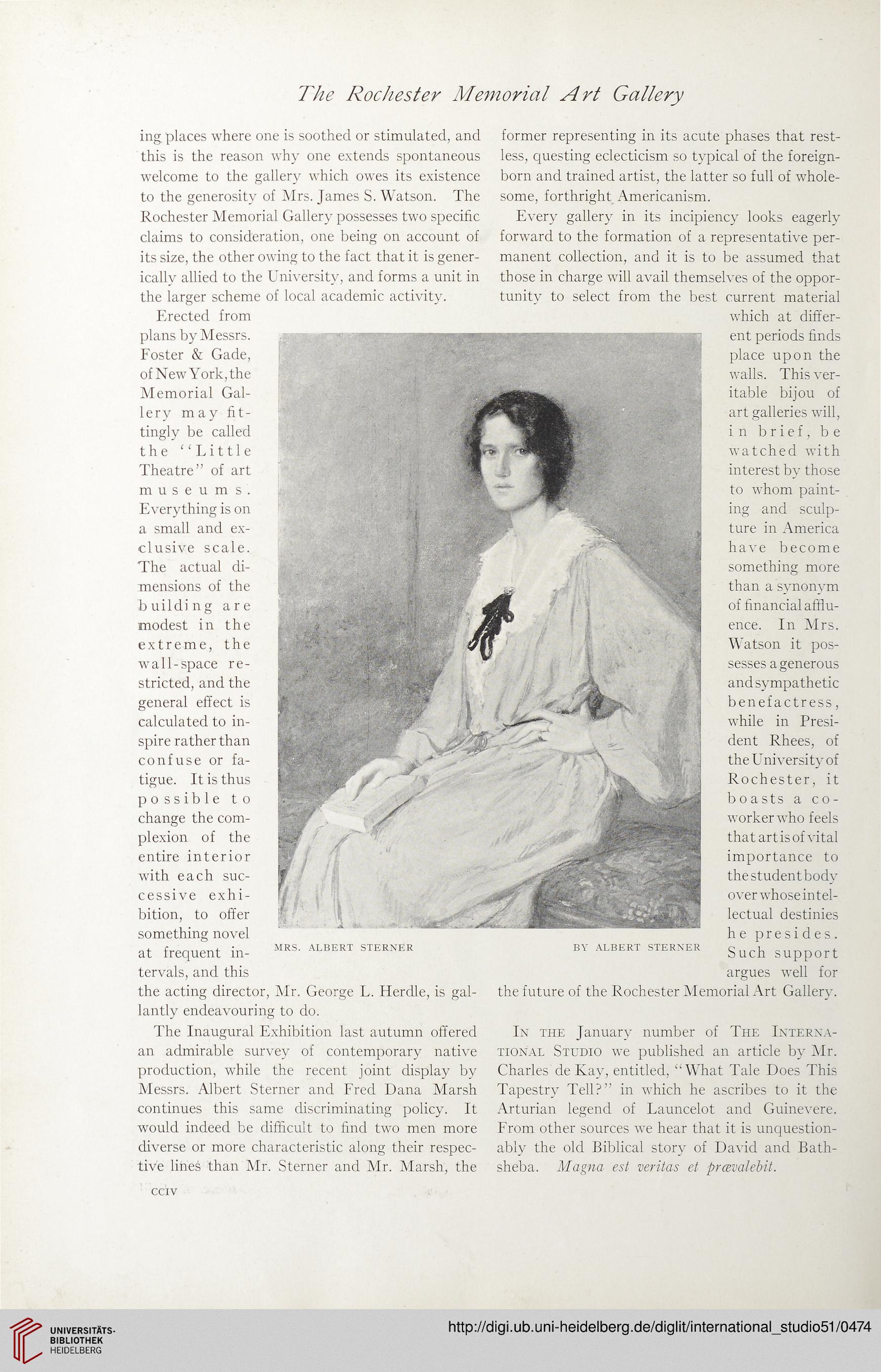The Rochester Memorial Art Gallery
ing. places where one is soothed or stimulated, and
this is the reason why one extends spontaneous
welcome to the gallery which owes its existence
former representing in its acute phases that rest-
less, questing eclecticism so typical of the foreign-
born and trained artist, the latter so full of whole-
to the generosity of Mrs. James S. Watson. The
Rochester Memorial Gallery possesses two specific
claims to consideration, one being on account of
its size, the other owing to the fact that it is gener-
ically allied to the University, and forms a unit in
the larger scheme of local academic activity.
Erected from
plans by Messrs.
Foster & Gade,
of New York, the
Memorial Gal¬
lery may fit¬
tingly be called
the “Little
Theatre” of art
museum s .
Everything is on
a small and ex¬
clusive scale.
The actual di¬
mensions of the
building are
modest in the
extreme, the
wall-space re¬
stricted, and the
general effect is
calculated to in¬
spire rather than
confuse or fa¬
tigue. It is thus
possible to
change the com¬
plexion of the
entire interior
with each suc¬
cessive exhi¬
bition, to offer
something novel
at frequent in¬
tervals, and this
some, forthright Americanism.
Every gallery in its incipiency looks eagerly
forward to the formation of a representative per-
manent collection, and it is to be assumed that
those in charge will avail themselves of the oppor-
tunity to select from the best current material
which at differ-
ent periods finds
place upon the
walls. This ver-
itable bijou of
art galleries will,
in brief, be
watched with
interest by those
to whom paint-
ing and sculp-
ture in America
have become
something more
than a synonym
of financial afflu-
ence. In Mrs.
Watson it pos-
sesses agenerous
and sympathetic
benefactress,
while in Presi-
dent Rhees, of
the University of
Rochester, it
boasts a co-
worker who feels
that art is of vital
importance to
the student body
over whose intel-
lectual destinies
he presides.
Such support
argues well for
MRS. ALBERT STERNER BY ALBERT STERNER
the acting director, Mr. George L. Herdle, is gal-
lantly endeavouring to do.
the future of the Rochester Memorial Art Gallery.
The Inaugural Exhibition last autumn offered
an admirable survey of contemporary native
production, while the recent joint display by
Messrs. Albert Sterner and Fred Dana Marsh
continues this same discriminating policy. It
would indeed be difficult to find two men more
diverse or more characteristic along their respec-
tive lines than Mr. Sterner and Mr. Marsh, the
In the January number of The Interna-
tional Studio we published an article by Mr.
Charles de Kay, entitled, “ What Tale Does This
Tapestry Tell?” in which he ascribes to it the
Arturian legend of Launcelot and Guinevere.
From other sources we hear that it is unquestion-
ably the old Biblical story of David and Bath-
sheba. Magna est veritas et prcevalebit.
cciv
ing. places where one is soothed or stimulated, and
this is the reason why one extends spontaneous
welcome to the gallery which owes its existence
former representing in its acute phases that rest-
less, questing eclecticism so typical of the foreign-
born and trained artist, the latter so full of whole-
to the generosity of Mrs. James S. Watson. The
Rochester Memorial Gallery possesses two specific
claims to consideration, one being on account of
its size, the other owing to the fact that it is gener-
ically allied to the University, and forms a unit in
the larger scheme of local academic activity.
Erected from
plans by Messrs.
Foster & Gade,
of New York, the
Memorial Gal¬
lery may fit¬
tingly be called
the “Little
Theatre” of art
museum s .
Everything is on
a small and ex¬
clusive scale.
The actual di¬
mensions of the
building are
modest in the
extreme, the
wall-space re¬
stricted, and the
general effect is
calculated to in¬
spire rather than
confuse or fa¬
tigue. It is thus
possible to
change the com¬
plexion of the
entire interior
with each suc¬
cessive exhi¬
bition, to offer
something novel
at frequent in¬
tervals, and this
some, forthright Americanism.
Every gallery in its incipiency looks eagerly
forward to the formation of a representative per-
manent collection, and it is to be assumed that
those in charge will avail themselves of the oppor-
tunity to select from the best current material
which at differ-
ent periods finds
place upon the
walls. This ver-
itable bijou of
art galleries will,
in brief, be
watched with
interest by those
to whom paint-
ing and sculp-
ture in America
have become
something more
than a synonym
of financial afflu-
ence. In Mrs.
Watson it pos-
sesses agenerous
and sympathetic
benefactress,
while in Presi-
dent Rhees, of
the University of
Rochester, it
boasts a co-
worker who feels
that art is of vital
importance to
the student body
over whose intel-
lectual destinies
he presides.
Such support
argues well for
MRS. ALBERT STERNER BY ALBERT STERNER
the acting director, Mr. George L. Herdle, is gal-
lantly endeavouring to do.
the future of the Rochester Memorial Art Gallery.
The Inaugural Exhibition last autumn offered
an admirable survey of contemporary native
production, while the recent joint display by
Messrs. Albert Sterner and Fred Dana Marsh
continues this same discriminating policy. It
would indeed be difficult to find two men more
diverse or more characteristic along their respec-
tive lines than Mr. Sterner and Mr. Marsh, the
In the January number of The Interna-
tional Studio we published an article by Mr.
Charles de Kay, entitled, “ What Tale Does This
Tapestry Tell?” in which he ascribes to it the
Arturian legend of Launcelot and Guinevere.
From other sources we hear that it is unquestion-
ably the old Biblical story of David and Bath-
sheba. Magna est veritas et prcevalebit.
cciv




